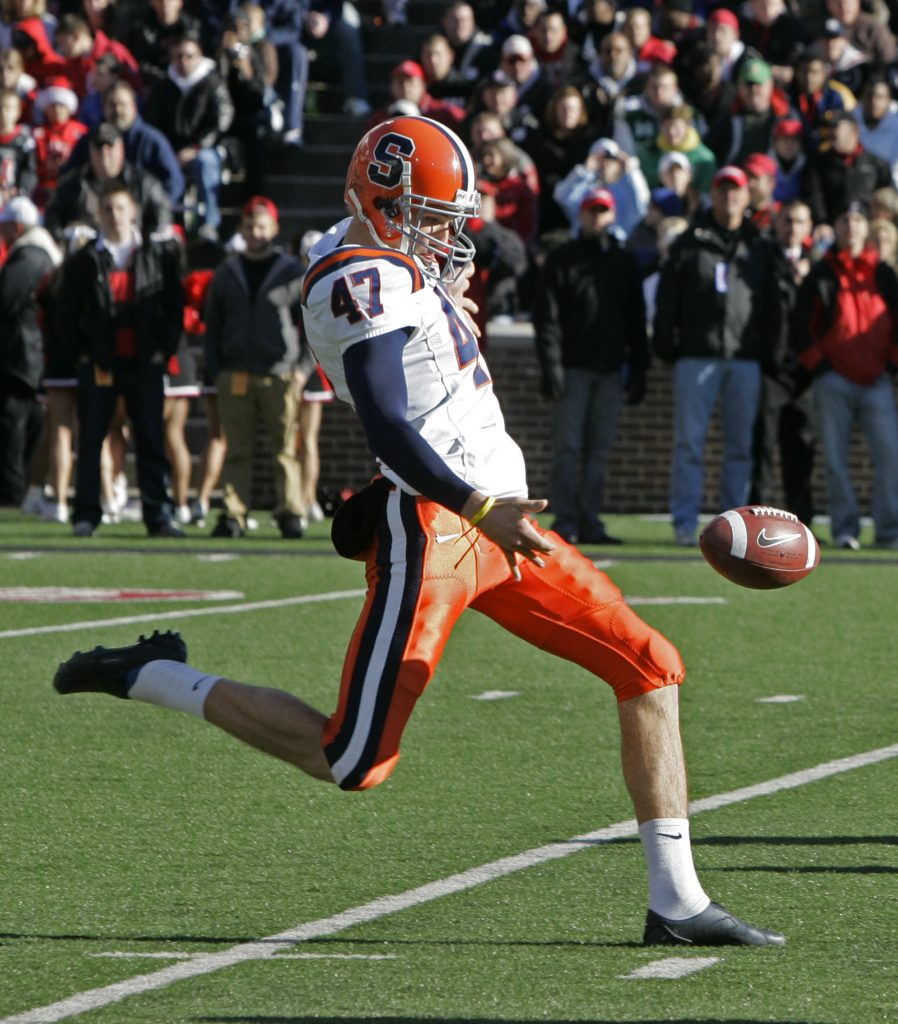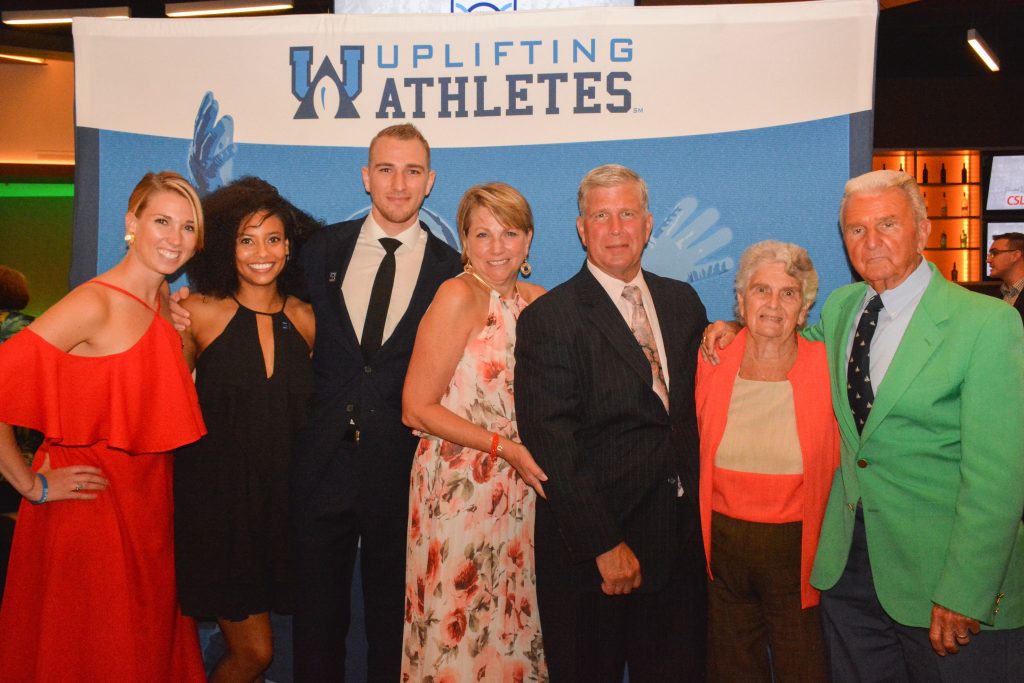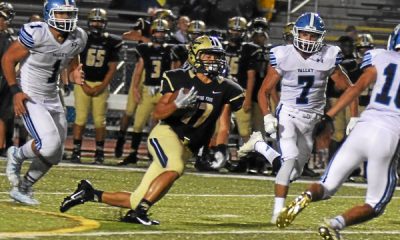
PHILADELPHIA >> As birthdays go, Rob Long’s 22nd was certainly memorable. But unlike all of the others, it was filled with deep anxiety and great regret.
Looking back, Long admits he wondered if it was going to be his last.
Eight birthdays later, the former Downingtown West High School football star has made it his mission to make every spin around the sun count.
“I understand I am a very lucky person to still be able to be alive,” Long said, thinking back on the day in 2010 when he underwent a surgical procedure that was about as complicated as it gets. “That’s never lost on me.”
***
In 2010, the former Downingtown West star was playing big-time college football at Syracuse, and was on the cusp of an NFL shot, when he was hit with an unimaginable new challenge: brain cancer.
All of the drive and passion he had for football, Long summoned to defeat cancer. And once that was accomplished after grueling treatment, he turned his attention to helping others who are in a similar battle.
“Does it take unique character to handle adversity, or is character revealed in adversity?” his high school head coach Mike Milano asked rhetorically. “In Rob’s case I think it was revealed to everybody. I knew about his character long before he got sick.”
On Dec. 13, 2010 — at a time he should have been preparing for the Pinstripe Bowl against Kansas State at Yankee Stadium — Long was at home in Downingtown, girding for the fight of his life. He was told the procedure the following day had great risks, including infection, paralysis, loss of sight and even death.
Long’s birthday meal includesd some of his favorites: a chicken cheesesteak for dinner and a banana split for dessert.
“It was surreal to say the least,” Long recalled. “I was wondering if this was the last birthday I’d ever see.”
KICKING OFF A FOOTBALL CAREER
Growing up, Long was a latecomer to football. His game was ice hockey. But in the summer of 2003, just before he started his freshman year of high school, Long unwittingly turned a few heads with his powerful leg.
He had a couple buddies who played football for the Marsh Creek Eagles Pop Warner squad and he caught the attention of coach Mike Biffel.
“I was waiting for them to finish practice, just hanging out, and I was kicking the football around,” Long said. “That’s when Mr. Biffel asked me if I wanted to play.”
Long told him that his dad, Bob, would be on board, but he didn’t think his mom, Mary Jo, would let him play football.
“By the time I got home, my mom said, ‘Why is Mr. Biffel calling me and asking if you can play football?’” he said.

Syracuse punter Rob Long against Cincinnati in an NCAA college football game, Saturday, Nov. 29, 2008, in Cincinnati. (AP Photo/Al Behrman)
Mom was eventually convinced and he played for the Eagles that season. It didn’t take much time to see that Long was the best kicker/punter on the team, and he started working on it. He received a kicking net as a gift the following Christmas, and proceeded to wear a hole in it.
Prior to his sophomore year, West head football coach, Mike Milano, took notice.
“Rob tells the story that I dragged him into my office and told him he had to play,” Milano laughed. “I was teaching phys ed classes back then and I’m sure at some point along the way one of my players said, ‘Hey, you got to get Rob Long on the team.’”
The meeting was a success, and despite being “140 pounds soaking wet,” Long won the job as the Whippets’ kicker and punter. It was around this time that he began working with local kicking coach, Jeff Dinnocenti, who had mentored Malvern Prep’s Brendan Carney, who preceded Long as the Syracuse punter.
“I took (Dinnocenti) up on the challenge to learn punting and it helped me tremendously,” Long said.
The running joke, according to Milano, was that Long wanted to be known as more than just a kicker.
“He wanted to play scout team quarterback,” Milano said.
As a senior, Long average more than 40 yards per punt, and was 5-of-6 on field goals and 40-41 on PATs. When he uncorked a 70-yard punt against West Chester Henderson, former Philadelphia Eagles coach Dick Vermeil just happened to be in the stands to see it.
“Vermeil was there because his grandson played for Henderson,” Long explained. “He called coach (Greg) Robinson at Syracuse, said that he should take a look at me, and I got an invite to visit.”
BECOMING A COLLEGE STANDOUT
In December of 2002, Long and his parents took an official recruiting visit to cold and snowy Syracuse.
“But then I walked into the Carrier Dome and it was the biggest place I’d ever seen,” Long said.
During the visit, Robinson expressed his desire to see Long playing for the Orange.
“We were a little naïve about what was happening,” he conceded. “I was afraid to ask, but my mom finally said, ‘Does this come with a scholarship of any kind?’”
Robinson replied: “Of course, it’s a full scholarship here if you want it.”
Long didn’t commit on the spot, but he sure wanted to.
“I actually wanted to call him before we got off I-81 in New York on the way back,” he laughed.
A starter immediately, Long averaged 44.5 yards per punt in his college debut against Washington on a Friday evening.
“The Carrier Dome was full,” he said. “I was 18-years-old playing in front of 45,000-plus fans in a nationally televised game. I had a blast.
“I don’t think I understood what a big deal it was at the time. Maybe that’s why I was able to perform as well as I did.”
He was named to the Sporting News Freshman All-American team, and went on to be a two-time All-Big East selection, and a team captain as a junior and senior.
“I wasn’t surprised how he did at Syracuse,” Milano said. “I was surprised that it was his only (NCAA Division I) offer. The recruiting for kickers is much different than other positions.
“His success really hit me when he was first named a captain. To be a captain as a punter/kicker is unbelievable. And then to also be a two-year captain? That’s off the charts.
“But we weren’t surprised. We knew what kind of a kid he was. He was one of the most beloved kids at Downingtown West.”
But a dark cloud was gathering. Nobody knew it, but heading into his senior season trouble was on the way. After flying cross-country for his senior season opener at Washington, Long first started experiencing some troubling symptoms.
‘THERE IS SOMETHING WRONG WITH ME’
At the team hotel in Seattle, just after having dinner with his teammates on the eve of the game, Long felt miserable.
“I became very sick,” he said. “I couldn’t keep anything down. Up until game time I was drinking Pedialyte and trying to rehydrate, and somehow I had a good game.
“But looking back, it was the first time I had any symptoms.”
Nausea and chronic headaches followed each of the remaining five flights that season, but the episodes were just far enough apart that it didn’t yet raise any red flags. But on Thanksgiving Day of 2010, Long woke up gravely ill.
He dragged himself to the Syracuse football complex to see the training staff, and with tears in his eyes, he said: “There is something wrong with me.”
Tests for everything from a stomach virus to food poisoning came up negative. Just prior to the season finale against Boston College, Long typed his symptoms into his cell phone and “brain tumor” popped up.
“I thought: ‘It’s obviously not that,’” he said.
For his final regular season game, Long’s parents put together a 55-passenger bus from Downingtown that was packed with family, friends, high school buddies and even his former coach Milano. And despite the intermittent headaches, it was a large and successful celebration of an excellent college career.
“It was one of those moments I will remember forever,” Long said.
“The apple doesn’t fall far from the tree,” Milano added. “I got to meet his extended family on the bus and they are awesome people.
“But here was the dark side of that bus ride. They were playing a movie on the way up and it was ‘The Express.’ It’s about (Syracuse’s 1961 Heisman Trophy winner) Ernie Davis, who gets sick with cancer. And then we found out within a week that Rob has a brain tumor.
“That was pretty eerie,” Milano said.
The following week, Long visited the team doctor, who sent him for an MRI. Long says he remembers clearly thinking about the ridiculousness of it all while lying inside the cylindrical scanner on Dec. 2, 2010.
“But when the radiologist came out after the MRI, she looked as white as a ghost,” Long recalled. “Eight years later, I know exactly what was happening, but back then I had no clue.”
Later that same day, he was called to meet with team doctors, the entire training staff and even some coaches. That was the traditional audience when a player was being told that they had suffered a season-ending injury.
“I had not yet seen the MRI, but when I saw all of them, I said, ‘Well, this can’t be good,’” he said. “Nobody laughed or said anything.”
He was told that a large growth was found in his brain and that he would have to see a specialist as soon as possible. Long admits that at this point he did not understand the magnitude of the situation.
His first phone call was to his dad, who had some difficult news of his own.
“He said that my aunt Chrissie, my Mom’s youngest sister, had just been diagnosed with breast cancer eight hours earlier,” Long said.
“So, let’s just say it was a tough day.”
TOUGH APPOINTMENT FOR A SERIOUS PROCEEDURE
Long didn’t have the heart to talk to his mom that day about his situation. The following day he saw the MRI for the first time. It was a black and white image looking down at the top of his brain.
“I didn’t even know what I was looking at,” he said. “I saw the four quadrants of the brain. They told me that the large white spot is not supposed to be there. At that moment, I realized that I was in a bad situation.
“It knocked me off my feet, quite literally. I stepped back into a chair. The neurosurgeon said I had a large brain tumor, the size of a tennis ball. It took up a quarter of my brain.”
The nausea and headaches were his body’s reaction to the growing tumor. The immediate concern was the chance of seizures and/or strokes. Long was advised to return home to be with his family and seek emergency surgery at one of the many respected hospitals in the Philadelphia area.
Word spread quickly, and family friend Father George McGee — a priest at Villanova — called his doctor at Thomas Jefferson Hospital for a recommendation. He suggested the world-renowned David Andrews, the chief of neurosurgery at Thomas Jefferson.
Initially told there was a six-month wait to see Andrews, somehow Father George was able to secure an appointment a few days later.
“Dr. Andrews was phenomenal,” Long pointed out. “He said, ‘I understand you have a tumor and we are going to that thing out of there.’
“He explained the procedure as ice fishing on my brain. Drill a hole, get the tumor out and put the skull back on.”
The surgery took nearly five hours and Andrews was able to remove more than 90 percent of the tumor. Successful brain surgery of this type is anything over 60 percent.
DEVASTATING DIAGNOSIS; AGGRESSIVE TREATMENT
It was six anxious days until he received the results of the pathology report. The first question from his doctor upon entering the room was: is there a history of brain cancer in your family?
“I thought to myself that this isn’t a good start to the conversation,” Long said.
“That’s when they told me I was diagnosed with a grade III anaplastic astrocytoma. It’s hard to recall it all, but I do remember my mom collapsing on the floor.”
It is a rare malignant tumor, grade three is the most aggressive form, and — he was told — there is no cure.
“That’s not what you want to hear at any age,” Long said. “I was 22.”
The statistics on grade III anaplastic astrocytoma are quite daunting: the five-year survival rate was about 14 percent at the time. And there was a family history of brain cancer.
“My mom lost her father to brain cancer when he was 35 and she was just 7 years old,” he said. “It was very difficult for her to hear. I can only imagine.”
It was a lot of bad news. The good news was that Long was a Division I football player in the best shape of his life.
“I was strong and fit. I thought I was headed to the NFL,” he declared. “I was projected as one of the best punters in that draft class. There was no reason I wasn’t going to get an opportunity to play either through the draft or free agency.
“At that point, that was all I was focused on. And it was a matter of months away, and in seconds, it all went away. It was devastating.”
There were several ways to proceed, but it was decided to go with an aggressive treatment option. And the program began with six and a half weeks of chemotherapy and radiation therapy followed by a month of recovery time.
“I just remember being sick for Rob,” Milano said. “He would have been, and maybe would still be, kicking in the NFL. That’s my belief. I’ve had some great kids who have worked hard, but nobody worked harder than he did.”
In late March of 2011, Long had a checkup MRI, and was told not to expect much. But afterwards, Andrews said, ‘You have to see this.’
“He pulled up the MRI and said, ‘I don’t know if it’s a miracle or not but I see no visible signs of cancer,’” Long reported. “We all sat their completely stunned. He said, ‘You still have a long road, but this is remarkable.’”
POTENT TREATMENT TAKES A TOLL
Despite the miraculous MRI, Long’s aggressive treatment regimen continued for another 13 months. But he was not yet ready to give up on his football dreams.
“It took a large physical, mental and emotional toll on my body over the next 14 months,” Long said. “It was incredibly grueling, and at the same time I still had aspirations to play in the NFL.”
Amazingly, while undergoing a full year of chemotherapy, Long still somehow found the strength to work out daily with Darren Wasser, the strength coach at Downingtown East, and fellow Downingtown product Pat Devlin, who quarterbacked Penn State and Delaware and was prepping for the NFL Draft. Long even had a pre-draft workout with the Cleveland Browns.
“It felt like the right thing to do, but looking back I obviously wasn’t ready for that,” Long acknowledged.
In the span of about a month, Long’s weight dropped from 205 to 165 pounds. He remembers looking at his pillow one morning and it looked like someone had “shaved a golden retriever.” He would run his fingers over his scalp and would pull out clumps of hair.
“It was like, ‘wow, I am pretty sick and the treatment is pretty potent,’” he said.
“I’ve seen videos from back then and I had almost no muscle mass. I remember looking at myself in the mirror one day — and I was always a fit kid — and I had no chest or arm muscles. I had abs because everything else was gone.”
Long plowed ahead, however, not wanting his bout with cancer to end his football career. He admits that he had a chip on his shoulder, but after the surgery and treatment, he had to start all over again.
Through a bunch of clear MRIs and several years of hard work, Long got his strength back and eventually began booming punts like he used to do.
“It got to a point where I thought I was punting better than I was in college,” he said.
He proceeded to secure about a dozen workouts with NFL teams, including the Philadelphia Eagles and Dallas Cowboys. And even though most came away impressed, there was the reality that there are only 32 NFL punting jobs in the world.
“It became not just an ability issue but an opportunity issue,” Long said. “After trying for 18 months I had a long talk with myself. I’d been through so much and I just felt that I didn’t need football to be successful.
“I walked away and tried to find my new passion.”
MOVING ON TO A NEW PASSION
Long became involved with Uplifting Athletes when Syracuse opened a chapter in his honor in 2013. It’s a non-profit organization of current college football players which raises funds and promotes awareness benefiting those with rare diseases.
After going back to Syracuse to get his masters degree, Long had several unfulfilling jobs, but in 2016 he pursued and landed a full-time position with Uplifting Athletes.
“It was one of those serendipitous opportunities,” he said. “I wanted to help and it became my passion.”
He held multiple positions over the next few years including chapter manager (there are now 30-plus chapters), director of rare disease engagement and director of strategic development. And late last year, Long was elevated to executive director.
“Can you imagine a better person for that job?” Milano said. “I can’t. I think he is a perfect fit.”
In the organization’s 12-year history, it’s raised more than $4.5 million in support of the Rare Disease Community, including $180,000 in research grants in the last 12 months through the program Long developed called the Young Investigator Draft.
“I’m incredibly proud of what we’ve accomplished,” Long said. “We are a small team but we’ve been impactful and we are only scratching the surface of what we can accomplish.”
As if he needed any more motivation, Long was hit with another family tragedy when his Aunt Chrissie — who was cancer-free for four years — was diagnosed with a cancerous brain tumor and died in 2018.
TACKLING CHALLENGES; HELPING OTHERS
Even though he was healthy, all of the ups and downs of the previous years continued to weigh on Long, and in 2018, he was diagnosed with post-traumatic stress disorder.
“One thing they don’t tell you, if you survive, that there’s a mental component that is as big of a fight as the physical part of it,” Long explained.
“There was a long period of time after my diagnosis, that I really didn’t understand why I felt the anxiety and emotions I would have, and the things that would trigger the disorder.”
But eight-and-a-half years after being given a three-to-five year prognosis, Long is receiving treatment for PTSD and is thriving. He is a healthy 195 pounds and was recently married. He lives with his new wife, Irie, in South Philadelphia.
“It’s been life-changing for me, and I don’t say that lightly,” Long said of his PTSD treatment. “I am in a position now with the job I hold that I have to take care of myself so I can perform the job.
“I knew when I signed up for it that I would have to talk about the worst days of my life almost daily. I am more than willing to do that if I can help others and give them hope.
“I firmly believe that I am the luckiest person the world and I’m just trying to take my second opportunity at life and make the most of it — and help as many people along the way if I can.”






















